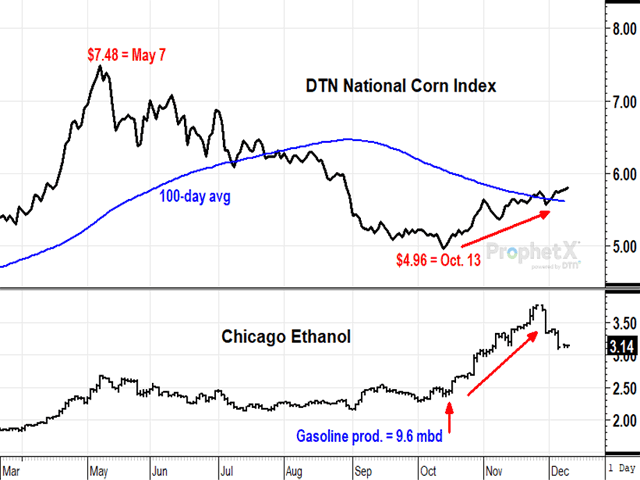Todd's Take
New EPA Announcements Raise Questions for Biofuels Industry
If you caught Wednesday's (Dec. 8) DTN article by Staff Reporter Todd Neeley (see https://www.dtnpf.com/…), you saw Tuesday's (Dec. 7) announcements from the Environmental Protection Agency (EPA) drew mixed reviews from politicians, renewable fuels groups and farm groups. Depending on who you listen to, Tuesday's announcements were either a devastating betrayal of corn and soybean farmers or a reasonable adjustment to the demand disruption that resulted from the pandemic.
My initial reaction was that the lower renewable volume obligations (RVOs) of 12.5 billion gallons for corn-based ethanol in 2020 and 13.32 billion gallons in 2021 were largely explained by the drops in gasoline production in 2020 and 2021 that resulted from the pandemic. I was encouraged to see EPA deny 65 requests of small refinery exemptions and approve $800 million in aid for biofuels producers.
However, a friend pointed out conflicting arguments that made me step back and take a harder look at the numbers. Was I missing an important part of the argument? The ethanol mandate laws and procedures are not easy topics to understand, and I wanted to get it right for myself and DTN customers. This is also a politically hot topic and sensitive issue for many -- another good reason to take a closer look.
The contrary argument that made me pause was basically this:
Tuesday's announcement from USDA that the renewable volume obligation for corn-based ethanol will be lowered to 12.5 billion gallons for 2020 and lowered to 13.32 billion gallons for 2021 are providing credits to refiners, which they will use as a free pass on having to blend the full 15.0 billion gallons in 2022. In effect, EPA has effectively reduced the mandate and the change will be bearish for corn demand.
To sort this out, I enlisted the help of DTN Staff Reporter Todd Neeley. For years, Neeley has written extensively on biofuels topics for DTN and is well versed in the matter. Neeley is also a patient fellow, answering my questions with well-explained replies. This week, you're getting two Todds for the price of one.
P[L1] D[0x0] M[300x250] OOP[F] ADUNIT[] T[]
As I posed the dilemma to Neeley, his first reply was that the argument in question was essentially correct. By reducing the RVOs for 2020 and 2021, EPA had effectively made more RINs available that could be applied as a pass on future blending requirements.
While Neeley was in the process of replying, I was digging up the numbers from the U.S. Energy Department and USDA's Global Ag Trade system. Before COVID-19, in 2019, U.S. ethanol production minus exports came to 14.32 billion gallons, slightly more than 10% of that year's gasoline production.
In 2020, U.S. ethanol production minus exports totaled 12.56 billion gallons or 10.05% of gasoline production. In the first 49 weeks of 2021, ethanol production minus exports totaled 14.08 billion gallons or 10.28% of gasoline production. In all three years, the mandate of blending 10% of gasoline production was met, despite the challenges of the pandemic.
It is important to remember that on Dec. 19, 2019, before the pandemic hit, EPA set the RVO for corn-based ethanol at 14.41 billion gallons for 2020 and at 15.0 billion gallons for 2021 and 2022. In 2020, some refiners met their blending requirements and some fell short. As an industry, however, the refiners met the requirements, but likely also bought more RINs than needed, knowing the RVO was set higher than needed, at 14.41 billion gallons. For 2020, the 12.5-billion-gallon RVO is roughly a reasonable adjustment that will prevent refiners from being punished after they met the blending mandate.
For this year of 2021, refiners are on track to meet blending requirements and may have again bought more RINs than needed, knowing the RVO was earlier set at 15.0 billion gallons. With 14.08 billion gallons of ethanol already blended in 2021, I'm not sure how EPA arrived at an RVO of 13.32 billion gallons for 2021. In this case, it does appear EPA's lower RVO will result in refiners being issued more free passes on future blending than can be explained by gasoline demand that is running about 4% lower than in 2019.
Do the 65 denials of small refinery exemptions and $800 million of aid for biofuel producers make up for the partial relief offered to refiners? I'll let others debate that.
With some empathy for those pointing out the benefits that refiners received in Tuesday's decision, I would say this is no time to be glum about the prospects for ethanol demand in 2021. So far in 2021, ethanol production is running 8% above last year's pace and is above pace compared to USDA's corn demand estimate for ethanol of 5.25 billion bushels.
U.S. oil production remains impaired by last year's financial devastation in the oil patch and U.S. oil production is down 1.4 million barrels per day compared to where it was before COVID-19. The case for ethanol demand is currently the best it has been since 2008, the last time the country needed help extending its fuel supplies.
March corn closed at $5.91 3/4 Thursday, Dec. 9, which is a little over a nickel higher from Tuesday's close when EPA made its announcement. Deliveries of December corn have been light and current ethanol margins remain highly profitable for plants to keep producing.
Like many, I wish EPA would turn in its homework on time, but my best guess is that Tuesday's EPA announcement will have no significant effect on depressing corn demand for ethanol.
**
Comments above are for educational purposes only and are not meant as specific trade recommendations. The buying and selling of grain or grain futures or options involve substantial risk and are not suitable for everyone.
Todd Hultman can be reached at Todd.Hultman@dtn.com
Follow him on Twitter @ToddHultman1
(c) Copyright 2021 DTN, LLC. All rights reserved.




